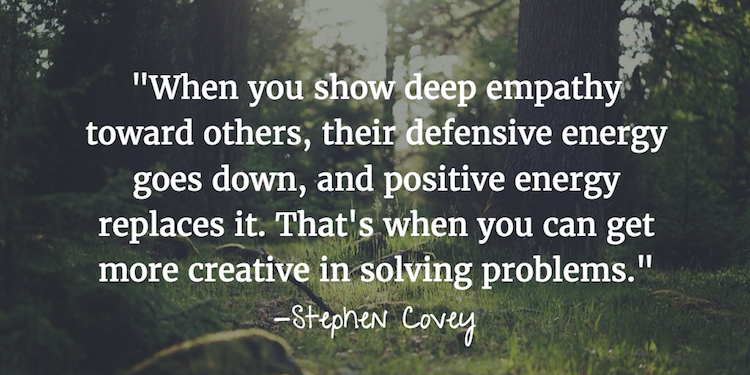Have you ever walked away from a conversation with your manager and think, “Wow, that conversation went so well — they truly care about me.”
I recently felt that way after my first meeting with my new manager, Cassie.
I thought to myself, “How did she do that?”
I reflected on how I could learn about a few of the ways Cassie empathized with me during our first one-on-one meeting. She made me feel comfortable and cared about almost immediately. She was innately curious about my job responsibilities, and how I balance my overall well-being at work.
Ultimately, what I felt led me to ask this question: How can we express our values through everyday interactions that makes work feel like something more than just “work?”
We can practice empathy in a variety of everyday interactions — during parent phone calls, filling out forms, submitting administrative reports, and simple day-to-day interactions. How we choose to act and respond communicates our values to others.
Virgin Pulse’s report Labor of Love: What Employees Love About Work & How to Keep the Spark Alive explains that workplace happiness doesn’t always come from a big paycheck — it could be something more culture-related like implementing flexible working hours so that employees can accommodate personal responsibilities. Our workplace happiness often comes from intangible items like having clear goals, having managers who are equipped to lead teams, and embracing a perspective to be more open to new ideas.
While some people are naturally more communicative and empathetic, it may be a difficult area for some team members to develop awareness around.
Leaders who prioritize empathy as a professional value consider the impact of their decisions on other people and communicate change well in an organization.
I’ve seen first-hand the impact that empathetic communication has on a team. A few years ago, I was part of a major restructure in a student affairs department. All levels of employees were impacted, including students. I noticed that the leaders who communicated with a high level of empathy to their employees were able to manage emotions more productively and rebound faster from the news. I was once told that empathy is “the glue that keeps people together through the peaks and valleys of life”.
Empathy isn’t just an action — it’s a core value that can be learned and strengthened. So, I rounded-up a few exercises that teams can turn to before the going gets tough.
Let’s dive in!
You’ve Got Values
In the early stages of identifying and defining values, it can take some momentum to get the entire team on board.
The first step in determining team values is taking the time to reflect on individual values. You can do this before a group meeting as an assignment, or you can set aside 10 minutes during a brainstorming meeting for individual thought.
And if you’re a manager, it’s important to think about your personal values before a group discussion. So grab a pen and paper and do some quick reflecting:
What is important to you in a workplace environment?
What is unique about working at your job? (What makes it memorable?)
What personal talents or skills do you specifically bring to the team?
When I met with Cassie for our first one-on-one, she specifically asked me a few questions around my personal behaviors, which helped us build a relationship grounded in empathy.
She shared with me Questions for Our First 1:1 created by Lara Hogan, the VP of Engineering at Kickstarter. It helped me identify my needs, and I had the space to explain how she can best support me in my role. And let me tell you — it was also a great resource for boosting my emotional intelligence. If you’re not super self-aware of how your emotions drive communication and where to start in building empathy in the workplace, this a great foundational resource.
Spreading The Love
The Drucker exercise, adapted from organizational management expert Peter Drucker, is an in-depth way to understand how to adopt an empathetic lens with the team at-large to improve communication.

The goal of this exercise is to get everyone sharing their values out loud.
Many people — especially perfectionists and people new to their fields — hold the discomfort (and possibly shame) of past projects gone wrong and moments of failed communication close to their hearts. By encouraging people to share thoughts and emotions, this activity creates a space where people can learn how to be proactive, so that past issues don’t resurface.
How to get started:
Have people answer these questions on their own, while in a group setting or before the activity.
What are you best at?
- What are your top strengths?
- Where can we expect you to shine?
How do you perform?
- When are you most productive?
- How do you like to work?
- What workplace things bother you?
What do you stand for?
- What is important to you in your work life?
- Where won’t you compromise?
Give each person about 20 minutes to engage in reflection, then open up discussion and allow 2 minutes for each person to share with the group. Don’t let people interrupt, disagree, or devalue: The activity is just as much about listening mindfully as it is about sharing something that is personal in the workplace. After each person has shared, say “Thank you for sharing that with the group.”
Once everyone in the group has contributed, allow each person to contribute a closing comment to help resolve any loose feelings.
Cross-company communication is positively impacted when you define values. At a basic level, it ensures that everyone at your company understands the organization’s identity relative to their own, which will lead to staff members better serving as brand advocates in the community. When you understand your company’s values, you can:
- Explain what your company stands for in just a few words,
- Quickly sum up how your team works together, and
- Provide clarity around on-boarding people to the culture of your organization.
At its best, value-defining increases productivity, fosters collaboration, and feeds creativity by reducing communication style-related friction between teammates and building an environment where feedback is both welcome and respected.
Here at Presence we’ve intentionally created a culture of feedback, and we often remind each other of it. That means before submitting or creating the final version of anything, we have to give each other feedback. Typically this looks like getting feedback in the beginning stages of a project, or schedule a quick lunchtime brainstorm to get feedback from people in different parts of the company.
In our office, it’s common to hear “Thanks for the feedback!” We believe that ongoing feedback truly helps us all gain perspective on something that we may not have considered in the first place. If I find myself pushing through a project solo, I remind myself to reach out to someone. Otherwise, I’ll most likely have to re-do what I’m working on because I didn’t incorporate different perspectives that may be crucial to the success of my work.
If you’re looking to begin the process of defining your company’s values, check out this guide from Delivering Happiness — it breaks the components of value implementation down into 10 actionable steps.
Creating a culture of empathy doesn’t just happen. It’s intentional. And when we take it upon ourselves to understand our personal values — including empathy — we can start making progress in other areas with our teams.
Values-defining isn’t just for strategic planning — it’s personal. It impacts the way we lead and motivate the people who make up the core of our organizations. It’s not just a feeling. It’s the authentic verbal and nonverbal communication and behavior we bring into the workplace and weave into each project.
In the High Resolution Impact Report, empathy was the cited as a critical driver of performance and labeled as the top ‘interaction skill,’ specifically related to one’s ability to participate successfully in conversations.

What tools do you utilize to encourage reflection on your team’s values?
How have you seen the culture of your organization change over time?
Has your student affairs team ever formally discussed values?
I’d love to continue the conversation online, feel free to send me a tweet @kayleyrobsham!





